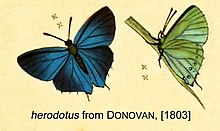Cyanophrys herodotus
| Cyanophrys herodotus | |
|---|---|

| |
| Scientific classification | |
| Domain: | Eukaryota |
| Kingdom: | Animalia |
| Phylum: | Arthropoda |
| Class: | Insecta |
| Order: | Lepidoptera |
| Family: | Lycaenidae |
| Genus: | Cyanophrys |
| Species: | C. herodotus |
| Binomial name | |
| Cyanophrys herodotus (Fabricius, 1793) | |
| Synonyms | |
| |
Cyanophrys herodotus, the tropical green hairstreak or tropical greenstreak, is a butterfly of the family Lycaenidae. It was described by Johan Christian Fabricius in 1793. It is found in Mexico, Guatemala, Panama, Nicaragua, Colombia, Ecuador, Peru, Bolivia, Brazil, Paraguay and Argentina.[1] Rare strays can be found as far north as southern Texas.[2] The habitat consists of open disturbed areas in tropical and subtropical rainforests and cloudforests at altitudes ranging from 600 to about 2,000 meters.[3]
The wingspan is 22–29 mm. Adults are on wing from late May to late October in southern Texas. They are on wing year-round in Central America and Mexico. They feed on flower nectar.
The larvae feed on the leaves and flowers of various shrubs and trees, including Lantana camara, Cornutia grandifolia, Clerodendron paniculatum, Lithraea brasiliensis, Schinus molle, Mangifera indica and Mikania species.[4]
References
- ^ Savela, Markku. "Cyanophrys herodotus (Fabricius, 1793)". Lepidoptera and Some Other Life Forms. Retrieved September 29, 2019.
- ^ "770450.00 – 4309.1 – Cyanophrys herodotus – (Fabricius, 1793)". North American Moth Photographers Group. Mississippi State University. Retrieved September 29, 2019.
- ^ Butterflies of the Amazon and Andes
- ^ Lotts, Kelly & Naberhaus, Thomas (2017). "Tropical Greenstreak Cyanophrys herodotus (Fabricius, 1793)". Butterflies and Moths of North America. Retrieved September 29, 2019.
- "Cyanophrys herodotus (Fabricius, 1793) (Tropical Greenstreak)". Butterflies of America.
